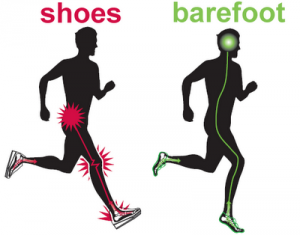Barefoot running… Good or Bad?
Posted on December 20th, 2011 by Andries Lodder

Article 1
“Changes in gait and EMG when walking with the Masai Barefoot Technique”
Claims by manufacturers:
- The Masai barefoot technology (MBT) is used as a treatment option within the field of physical therapy to treat leg, back or foot problems.
- They constructed a shoe with a rounded soft sole in anterior–posterior direction underneath the heel area, providing an unstable base of support with a rocker bottom. The function of the shoe is to transforms flat, hard, artificial surfaces into uneven surfaces, simulating the effect of walking barefoot, therefore stimulating the muscle activation in the foot continuously.
- The shoe forces people to walk more upright and thereby improving posture and is therefore used with patients with chronic back pain, as well as for patients with foot or circulatory problems where it is believed that the MBT shoes stimulate the intrinsic musculature of the foot and increases the blood flow.
- It is also used as a proprioceptive tool thereby enhancing ankle stabilizing musculature.
- Sports people use these shoes because it is believed to strengthen their leg muscles by wearing the shoes during their daily activity.
The purpose of the present study was to investigate how MBT changes the gait pattern and muscle activation.
Research Findings:
- When compared to walking in regular shoes, the cadence, stride length, step length, and walking speed were significantly decreased during the MBT condition.
- Stride time and single support significantly increased during the MBT condition.
- Movement patterns around the ankle joint showed major changes. Dorsiflexion angle at initial contact was increased and with these changes muscle activity of the lower extremities, especially the gastrocnemius and tibialis anterior, were found to be more prominent and more forcefully. The vastus lateralis and medialis were also found to have a greater muscle activity level as well as a greater degree in flexion during the stance phase of the gait cycle, which could have a negative effect on patients with knee problems.
- Subjects walked slower and with smaller steps as consequence off a decreased stride length due to decreased in hip flexion and ROM as well as a slower cadence.
Romkes, J., Rudmann, C. & Brunner, R. (2006). Changes in gait and EMG when walking with the masai barefoot technique. Clinical Biomechanics. 21 (1): 75 – 81.
Article 2
“In-shoe pressure distribution in “unstable” (MBT) shoes and flat-bottomed training shoes: A comparative study”
Claims by manufacturers:
- MBT shoe is designed to recreate a natural uneven walking surface to reduce problems caused by today’s rigid soled shoes and hard ground.
- The shoe is designed with an unstable rounded sole that distributes plantar pressure more equally and reduces the concentration of pressure on the heel.
- These shoes offer an additional form of conservative management for a number of foot and lower limb pathologies.
The aim of this study was to systematically assess the effect of the MBT shoe on plantar pressure.
Research Findings:
- The study revealed significant differences between the plantar pressure patterns found in individuals wearing MBT shoes compared to those found when they were wearing training shoes.
- Increased plantar pressures were found under the forefoot and toes, with a decrease in pressures under the midfoot and heel.
- The MBT shoes distribute the pressure more evenly across the metatarsals during loading phase.
- The rounded sole of the MBT design leads the individual to balancing on the front of the shoe were you have a even distribution of pressure over a greater surface area.
- Results indicate that the MBT shoe may be an effective aid to relieving midfoot and heel pressure.
Stewart, L., Gibson, J. N. & Thomson, C. E. (2007). In-shoe pressure distribution in “unstable” (MBT) shoes and flat-bottomed training shoes: a comparative study. Gait Posture. 25 (4): 648 – 651.
Windlass Effect
“A windlass is a hauling or lifting device consisting of a rope wound around a cylinder that is turned by a crank. The rope is analogous to the plantar fascia, and the cyclinder is analogous to the metatarsophalangeal joints” (Newmann, 2002, pp. 506).
When standing on once toes, or contacting of extrinsic plantar flexor muscles, the calcaneus raises and thereby shifting the distribution of body weight from the heel to the forefoot, or in this case over the metatarsal heads. Due to the hyperextension of the metatarsalphalangeal joints, the plantar fascia stretches and creates an increase angle of the medial longitudinal arch. Therefore strengthening the midfoot and hindfoot. With this occurring, the contraction of the intrinsic muscles provides additional reinforcement to the arch (Newmann, 2002, pp. 506).
Abnormal Pronation
Abnormal pronation mimics the effect of a foot with pes planus, or flat foot. This puts a limitation on the amount of height of a rise up on tiptoes. Accompanied with pes planus, comes a poorly supported medial longitudinal arch. Due to the lack of hyperextension of the metatarsalphalangeal joint, creates an unstable midfoot and forefoot due to the distribution of body weight being uneven over a area with little support were the arch remains flattened (Newmann, 2002, pp. 506).
Other Factors
- Weak extrinsic plantar flexor muscles could lead to loss in amount of lift of the heel.
- Lack of recoil and stretching ability of the plantar fascia could lead to the same.
- Abnormal supanation would shift body weight to lateral side of foot and decrease stability of the foot.
Tweet